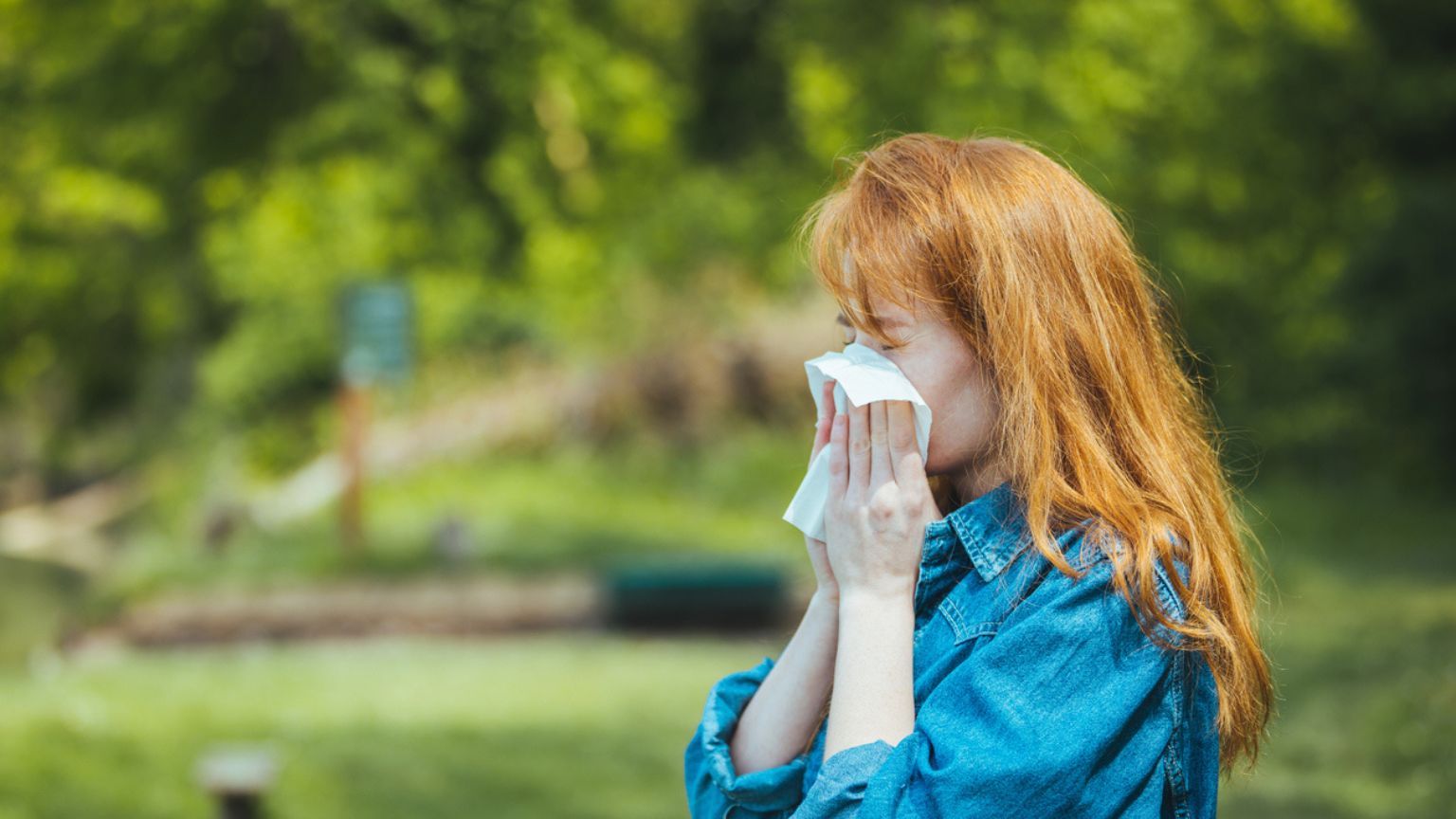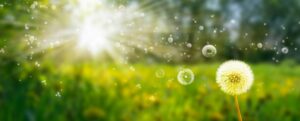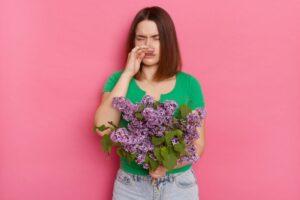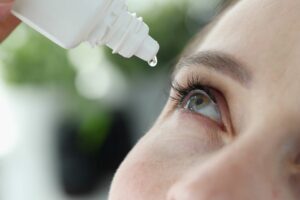Hay fever symptoms ruining the sunshine? Here’s 8 key things an expert wants you to know about allergy season
Around 20 per cent of us struggle come the spring season. Rather than looking forward to longer, sunnier days, many who struggle with hay fever symptoms are instead filled with dread.
Tree pollen which is the main trigger but there’s also a host of other allergens throughout the year which can cause a host of reactions from sneezing, watery, itchy and irritated eyes, runny nose and sometimes a cough.
‘As the climate on the earth begins to change, we will see an increase in CO2 in the atmosphere. This is a major growth factor for plants, trees and other flora, which may change growth their patterns,’ explains Dr Ross Walton, immunologist, and founder of A-IRCR.com.
Tree pollen which is the main trigger but there’s also a host of other allergens throughout the year
‘These changes could alter the flowering seasons, which in turn will prolong their pollen producing periods, and potentially increasing the total pollen burden released into the environment.
‘This is bad news for hay fever sufferers and who will not only experience a longer period of hay fever symptoms but potentially these changes will lead to an increase in the severity of their symptoms too’.
READ MORE: Hay fever symptoms? These 10 natural remedies will help
#1 Keep the pollen outside where it belongs!
Minimising pollen inside your home is key to reducing pollen circulating in your home. Anything that has been worn outside should be taken off before entering the home.
wash and shower as soon as you get inside
This includes shoes, all clothing and if possible wash and shower as soon as you get inside and if you have long hair it is worth washing or rinsing your hair as pollen attaches to you hair and ends up on bedding.
#2 Household chores checklist
Vacuum as much as possible and just be mindful when it comes to emptying your vacuum that you wear a mask and do it outside if possible.
Also, it is best to wet dust with a damp cloth rather than circulate pollen around with a feature duster.
Wash bedding regularly to get rid of any pollen that may have become attached. However, even if you don’t change all of your sheets, all of the time, it’s a good idea to at least change your pillow cases twice a week to ease your symptoms at night.
It may also be worth trying allergy-proof bedding, sometimes known as mite-proof bedding.
READ MORE: Hay fever driving you mad? 6 proven ways to reduce symptoms naturally
#3 Ditch the bouquets
Sadly, fresh flowers are a definite no-go for hay fever sufferers as it will only make symptoms worse!
Studies have shown that people living in rural areas, with greater exposure to diverse flora and fauna, have lower rates of allergies compared to their urban counterparts.
Urbanisation has long been associated with a higher incidence and severity of allergies
Recent studies looking at frequency and severity of allergy symptoms in a population of sufferers has linked the most frequent and severe symptoms to those living or being present in the most built-up and polluted areas.
‘Urbanisation has long been associated with a higher incidence and severity of allergies in the population,’ says Dr Walton.
‘The lack of exposure to diverse microorganisms, including those found in natural environments, and poorer air quality is thought to drive this phenomenon.
‘By promoting exposure to diverse flora, particularly in urban environments, we may be able to alleviate the burden of allergies on individuals and society’.
READ MORE: The secret to diet, exercise and skincare lies in your DNA
#4 Your environment checklist
Get exposed – stay in your local area and try to gain exposure to diverse flora which can help reduce the risk and severity of allergies over time. To do this, try spending more time in green spaces, gardening, and engaging in other outdoor activities.
Don’t give up on exercise – regular exercise helps support your immune system so don’t give up during the hay fever season. If you exercise outdoors, try and do it early morning or late evening, as most pollen peaks around noon or early evening.
Practical protection – wearing Vaseline around your nose to prevent allergens advancing up the nasal passages and wearing sunglasses to protect your eyes may help make you more comfortable when exercising outdoors, gaining the desensitisation benefits of exposure to local allergens.
#5 Take care of your microbiome
‘The gut microbiome, is a complex ecosystem of microorganisms populating the human digestive system, is increasingly being recognised as a crucial factor regulating the immune system and maintaining good health,’ says Dr Walton.
‘Recent research suggests that alterations in gut microbiota diversity and composition may be linked to the occurrence and severity of allergic diseases.
‘Individuals with allergies have been found to have different gut microbiota composition compared to non-allergic individuals.
Individuals with allergies have been found to have different gut microbiota
‘Additionally, interventions aimed at promoting gut microbiota diversity, such as prebiotics and probiotics, eating fermented foods and avoiding complex sugars which promote the expansion of unhelpful bacteria, have shown promise in alleviating allergy symptoms.
‘These findings emphasise the critical role of maintaining gut health in the management of allergic diseases’.
READ MORE: Gut Health & The Microbiome: The Nutritionist’s Guide – Part ONE
#6 Make diet savvy choices reduce the allergen load
Alison Cullen, a nutritionist working with A. Vogel advises the below changes will help to support you during the allergy season.
Chew your food – Simple food changes such as how we eat can help, by just chewing your food thoroughly your digestive responses will be stronger and offer faster satiety.
Reduce refined / processed foods – reduce your dietary intake of refined sugars and processed foods. Refined sugars feed unfriendly flora, so cut them back for a happier gut and immune system. Ditching processed foods and eating foods with high nutritional value improves immunity response to allergens.
Savvy swaps – think about the food you eat in terms of how healthy it is. It’s not always easy to afford organic food, but making small swaps to reduce pesticide exposure will help. Check out the ‘Dirty Dozen’ list of foods, these are the foods that contain the highest concentration of pesticides: either because their thin skins and high water content mean they absorb pesticides easily, or because they tend to have the most pesticides used on them.
Avoid histamine rich foods – If you are histamine-sensitive, reduce your exposure to high histamine foods such as:
- Alcoholic drinks,
- sauerkraut,
- vinegar,
- soy sauce,
- kefir,
- kombucha,
- yoghurt,
- olives,
- cured meats,
- sour cream,
- buttermilk,
- aged cheeses,
- dried fruit,
- citrus fruit,
- avocados,
- walnuts,
- cashews,
- peanuts,
- aubergine,
- spinach,
- tomato,
- tuna,
- anchovies,
- and sardines.
- Bananas, pineapple, papaya, and strawberries may also trigger histamine release.
If you are histamine sensitive it is likely that you will have far more dramatic symptoms, and the list of high histamine foods may well trigger responses such as rashes or feeling queasy or otherwise unwell.
READ MORE: From dry eyes to itchy skin – 5 signs you need omega 7
#7 Try over the counter support
There are a number of symptom-dampening products that can help support allergy sufferers, relieving debilitating symptoms caused by allergies, such as A.Vogel’s Pollinosan Luffa Hay fever Tablets, £11.99, which are a homeopathic medicinal product.
For those who struggle with itchy eyes which can be very annoying, the Pollinosan Hay fever Eye Drops, £13.99 are ideal to pop in your bag for throughout the day, plus they are a soothing solution for red, burning, itchy eyes and they can be used with contact lenses and are suitable for vegans.
#8 Be pollen savvy
Checking out the pollen count on a daily basis in your area is a great way to tool up and check what you need or keep your home environment as pollen free as possible.
Check your daily your pollen forecast here.
Like this article? Sign up to our newsletter to get more articles like this delivered straight to your inbox.


























































